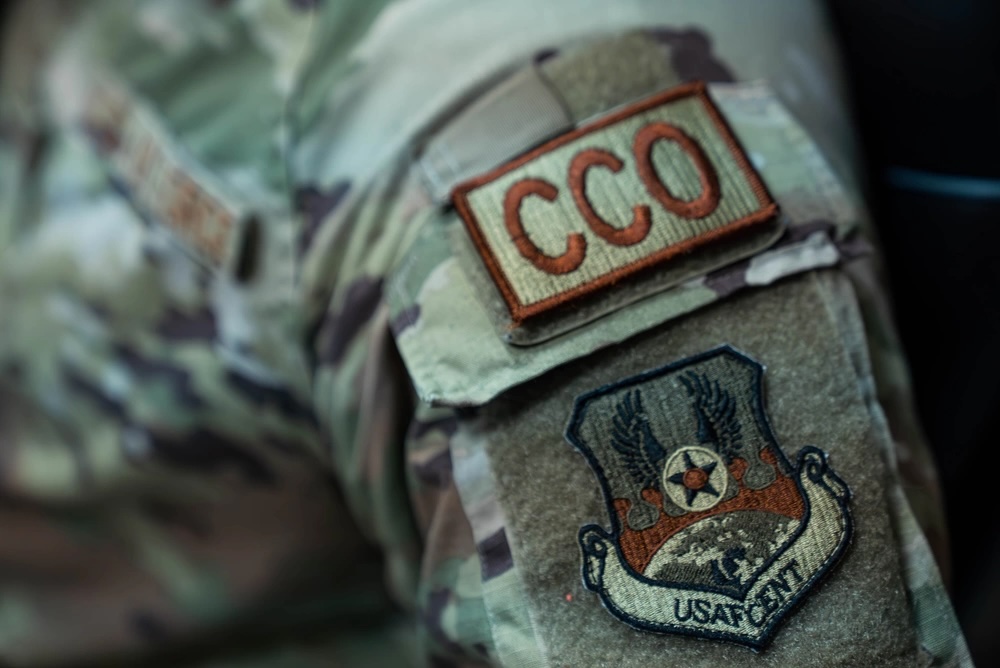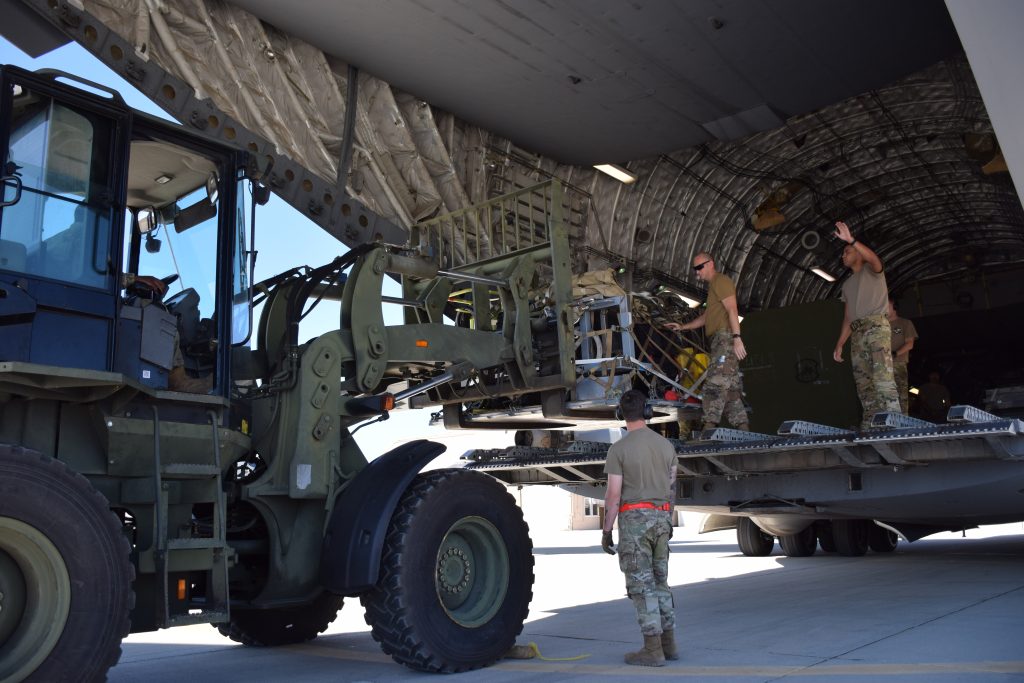The Air Force concept of Agile Combat Employment often involves forward arming and refueling points, rapid runway repairs, and other techniques for generating airpower at remote airstrips. But what happens when aircraft maintainers run out of water, or their electric generator needs more gas, or the food resupply flight is delayed?
Enter the contingency contracting officer (CCO), an Airman trained and authorized to spend taxpayer money on whatever the Air Force needs to accomplish its mission.
“Any time there are large-scale movements, something goes unaccounted for, something wasn’t immediately identified as a need,” said Staff Sgt. Milton Vasquez, a CCO with the 9th Reconnaissance Wing at the massive Bamboo Eagle exercise being held across the West Coast this week. “What I do is step in and find in the local economy what is available to support the mission set.”
By Aug. 5, the third day of the exercise, Vasquez had already driven hours to bring parts and supplies to Airmen working from airfields across the southern California desert. When an air conditioner for an operations room broke down, Vasquez and three civil engineers ran to Home Depot and bought another. When a field headquarters ran low on ice to cool its water tanks, Vasquez helped modify their contract so they could get more.
The list extends to rental cars, RVs, and even single-use serving utensils after the heating coil for a field kitchen sanitation unit went out.
“They were unable to sanitize their serving implements, and so they were unable to serve hot food, and that’s a huge hit to morale,” Vasquez said. “I just grabbed a ton of single-use serving utensils so they can continue to serve hot food without running afoul of health and safety.”

CCOs also free up cargo space aboard mobility aircraft; why bring in a ton of gravel and sand when you can buy it locally?
“That means the weight that we carry whenever we’re going to these locations can be more mission-focused as opposed to more sustainment-focused,” the staff sergeant explained.
CCOs must follow a long list of rules and regulations designed to prevent misuse of taxpayer money. For example, as a contractor, Vasquez can authorize the expenditure of funds, but a purchasing agent from a finance unit is responsible for actually handling the money, which may come in the form of U.S. dollars, or local currency.
The money is kept in a “cash cage” which may be a safe, an actual cage, or some other secure container, Vasquez said. At Bamboo Eagle, he used a government purchase card—basically a credit card for the government—arranged by finance Airmen. The regulation books for using that money are thousands of pages long, each with dense supplements.
“Government acquisitions are a beast and a half to work through,” Vasquez said. “While a civilian can just run a credit card … there are layers of bureaucracy and, for lack of a better term, red tape, that I have to navigate in order to do that above-board.”
Much of the red tape is waived in a state of emergency, such as a natural disaster, or a declared contingency, such as a war, but because Bamboo Eagle takes place in a non-contingency, non-emergency environment, Vasquez has to figure out a way to follow all the rules and regulations of peacetime procurement but also get Airmen the supplies they need quickly enough to perform in a fast-changing exercise.
“It’s proved to be a very interesting dilemma to work through,” he said.
On the other hand, CCOs have “a lot of trust and faith” from the Air Force to be responsible stewards of taxpayer dollars, Vasquez said. When a purchase costs more than the dollar amount a CCO is authorized to spend, there are rapid response teams available 24/7 at higher headquarters around the world ready to help authorize that spending.
From a strictly contracting perspective, the kind of work CCOs do on a regular basis is the same work they would do in a near-peer ACE environment, Vasquez said. The only wrinkle is that there are not enough CCOs to cover all the austere locations the Air Force may hope to operate in a near-peer conflict. For example, at Bamboo Eagle, Vasquez alone was responsible for three spoke locations: Edwards Air Force Base, Victorville, and March Air Reserve Base, spread over more than 100 miles of southern California.
“I’ve been going back and forth across all those locations the past several days to make sure everyone has exactly what they need,” he said.

The distances in a Pacific fight would be even greater, without a nearby Home Depot or roads to get between island airstrips. But Bamboo Eagle is proving difficult even with those luxuries.
The exercise is an extension of Red Flag, where large-scale air wargames begin and end at Nellis Air Force Base, Nev. Bamboo Eagle forces Airmen to project that same airpower from unfamiliar, unequipped airfields across the west coast. That means air and ground crews for fighter and bomber aircraft have to work closer than ever with mobility aircraft and support staff in order to stand up airfields, then quickly relocate if targeted by a missile strike.
“Traditionally a Red Flag or a Red Flag-like exercise stresses aircraft, aircrew, maintainers, and flightline-adjacent capabilities like munitions, fuels, avionics, et cetera,” Lt. Gen. Adrian L. Spain, deputy chief of staff of operations, said at an Aug. 1 media roundtable.
Bamboo Eagle, by contrast, “is designed to stress the entire ecosystem,” he said. “From all the support forces up to and including a wing commander and their staff in their ability to command and control a wide array of force elements under their command across dispersed locations.”
On a day-to-day level, that means working on the nitty-gritty details that make airpower possible: are the bomb carts and power generators loaded properly so that C-17s can safely fly them to a spoke? Once it gets there, are there enough forklifts to quickly download cargo before the C-17 can be targeted by a missile? If the spoke is targeted, how do Airmen request C-130s to take them and their equipment to a new one?
Airmen at all levels have to step outside their usual roles to make it work. Maintainers may have to marshal a C-130 on the runway, and cyber Airmen may have to learn how to pitch a tent or repair an HVAC unit. Meanwhile, wing commanders and headquarters staff have to morph from thinking like reconnaissance wings or fighter wings to air expeditionary wings that control fighters, tankers, airlift, drones, and other assets.
“I brought a bunch of reconnaissance Airmen into a situation where they are being asked to think like a fighter wing or a mobility wing,” said Col. Keagan McLeese, commander of the 9th Reconnaissance Wing. “It’s so far outside the box … that’s the point of the exercise, find our failings and learn from them.”
In the exercise, the 9th RW acted as the 9th Air Expeditionary Wing controlling several spokes from a hub at Edwards Air Force Base, Calif. When spoke leaders need anything, they know who to call.
“Some of the location commanders have my number on speed-dial, calling me any time they need something,” Vasquez said.
“We’re practicing all of this to get the ability to rapidly set up a base at a moment’s notice and to just as quickly tear it all down and move it someplace else,” the CCO added. “That way we stay effective and avoid any hostile intentions.”

